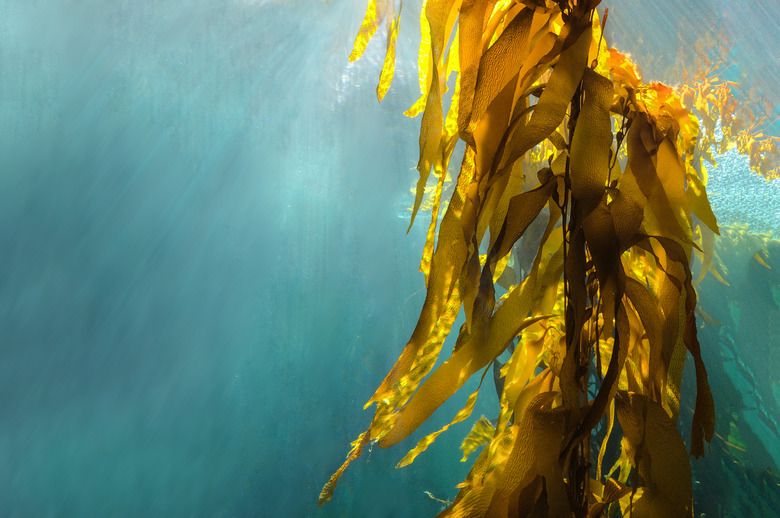Photosynthesis In Aquatic Plants
Plants are producers. Instead of consuming food to get energy, they make their own. During the process of photosynthesis, plants take in energy from sunlight and convert it into chemical energy stored in carbohydrates. Photosynthesis involves the same molecules and chemical reactions in land plants and aquatic plants. Floating plants photosynthesize much like plants that grow on land. However, the process presents more of a challenge for aquatic plants if they are fully submerged below the surface of the water.
Photosynthesis Basics
Photosynthesis Basics
Leaves are the main site for photosynthesis. Leaves contain chloroplasts, which are the organelles in plant cells where photosynthesis occurs. Chloroplasts contain molecules of chlorophyll that absorb visible light, mainly in red and blue wavelengths. Only a few molecules of chlorophyll absorb green wavelengths. As a result, plants appear green because they reflect more green light than they absorb.
Plants use the sugar made during photosynthesis to fuel growth, development, reproduction and repair. The simple sugars produced in photosynthesis bond to from more complex starches such as cellulose that provide structure to plants. In addition to providing a food source for animals and other consumers, photosynthesis also removes carbon dioxide from the environment and replenishes oxygen.
Stages of Photosynthesis
Stages of Photosynthesis
The two stages of photosynthesis are the light dependent and light independent reactions. Light dependent reactions involve the absorption of sunlight and the breakdown of water molecules into oxygen gas, hydrogen ions and electrons. The goal of this stage is to capture light energy and transfer it to the electrons to make energized molecules such as ATP. Oxygen is a waste product of this stage of photosynthesis.
The second stage of photosynthesis, also known as the Calvin cycle, uses the energized molecules created in the first stage to split carbon dioxide molecules taken in from the plant's environment. The breakdown of carbon dioxide and water molecules in the cell results in the formation of sugar molecules. Specifically, six molecules of carbon dioxide and six molecules of water yield one molecule of glucose, with six molecules of oxygen given off as a by-product.
Floating Plants
Floating Plants
Aquatic plants may take in carbon dioxide from the air or water, depending on whether their leaves float or are under water. The leaves of floating plants, such as lotus and water lilies, get direct sunlight. These types of aquatic plants do not require special adaptations to perform photosynthesis. They can take in carbon dioxide from the air and release oxygen into the air. The exposed surfaces of the leaves have a waxy cuticle to mitigate water loss to the atmosphere, like terrestrial plants.
Obtaining Carbon Dioxide
Obtaining Carbon Dioxide
Submerged plants, such as hornwort and sea grasses, use specific strategies to meet the challenges of conducting photosynthesis under water. Gases such as carbon dioxide diffuse much more slowly in water than in air. Plants that are fully submerged have greater difficulty obtaining the carbon dioxide they need. To help ameliorate this problem, underwater leaves lack a waxy coating because carbon dioxide is easier to absorb without this layer. Smaller leaves can more readily absorb carbon dioxide from the water, so submerged leaves maximize their surface to volume ratio. Some species supplement their carbon dioxide intake by extending a few leaves to the surface to absorb carbon dioxide from the air.
Absorbing Sunlight
Absorbing Sunlight
Adequate sunlight is also hard to come by for submerged plant species. The amount of light energy absorbed by an underwater plant is less than the energy that is available to land plants. Particles in water such as silt, minerals, animal waste and other organic debris reduce the amount of light that enters the water. Chloroplasts in these plants are often situated on the surface of the leaf to maximize exposure to light. As depth below the surface increases, the amount of sunlight available to aquatic plants decreases. Some plant species have anatomical, cellular or biochemical adaptations that allow them to carry out photosynthesis successfully in deep or murky water despite the decreased availability of sunlight.
Other Aquatic Producers
Other Aquatic Producers
Many organisms other than plants carry out the role of producer in aquatic ecosystems. Some forms of bacteria as well as algae and other protists perform photosynthesis. Colonies of single-celled algae work together to form the macroalga kelp, commonly known as seaweed.
Cite This Article
MLA
Mentzer, A.P.. "Photosynthesis In Aquatic Plants" sciencing.com, https://www.sciencing.com/photosynthesis-aquatic-plants-5816031/. 13 April 2018.
APA
Mentzer, A.P.. (2018, April 13). Photosynthesis In Aquatic Plants. sciencing.com. Retrieved from https://www.sciencing.com/photosynthesis-aquatic-plants-5816031/
Chicago
Mentzer, A.P.. Photosynthesis In Aquatic Plants last modified August 30, 2022. https://www.sciencing.com/photosynthesis-aquatic-plants-5816031/
